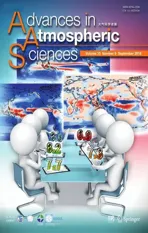Atmospheric Response to Mesoscale Ocean Eddies over the South China Sea
2018-06-29HaoyaLIUWeibiaoLIShuminCHENRongFANGandZhuoLI
Haoya LIU,Weibiao LI,Shumin CHEN,Rong FANG,and Zhuo LI
School of Atmospheric Sciences,Sun Yat-Sen University,Guangzhou 510275,China
1.Introduction
The atmosphere and the ocean constitute a coupled system that encompasses multiscale processes of exchange of momentum,heat,and matter.During past decades,largescale air–sea interactions such as ENSO and the MJO have been studied comprehensively(e.g.,Wang and Picaut,2004;Zhang,2005).In recent years,air–sea interaction processes of mesoscale ocean eddies and other mesoscale ocean features with spatial scales of 100–1000 km have drawn increasing concern because of their signi fi cant impacts on the atmosphere(Whiteand Annis,2003;Brachetetal.,2012;Chelton,2013;Lambaerts et al.,2013;Seo et al.,2016).One of the most prominent mesoscale characteristics is the positive correlation between surface wind speed and sea surface temperature(SST),which is di ff erent from the negative correlation found for large-scale air–sea interaction in which the ocean is usually forced by the atmosphere(Nonaka and Xie,2003;Xie,2004;Skyllingstad et al.,2007;Chelton and Xie,2010).Within mesoscale eddies,vorticities of rotating anticyclonic and cyclonic eddies generate areas of downwelling and upwelling that result in positive and negative SST anomalies,respectively(Gaube et al.,2015;Sabu et al.,2015).Moreover,eddies under large background temperature gradients might also induce anomalous horizontal SST advection.In this situation,maximal SST anomalies can also be found on eddy edges(Nonaka and Xie,2003;Chow and Liu,2012;Hausmann and Czaja,2012).Eddy-induced SST anomalies(normally<1◦C)have remarkable in fl uences on the overlying atmosphere,as revealed in the northeastern Atlantic(Bourras et al.,2004),South Atlantic(Frenger et al.,2013;Byrne et al.,2015),Aghulas Return Current(Messager and Swart,2016),and Kuroshio Extension(Putrasahan et al.,2013;Ma et al.,2015,2016;Chen et al.,2017).Two principal mechanisms have been cited to explain the atmospheric responses.The fi rst is the vertical mixing mechanism,which emphasizes how eddy-induced SST anomalies changethestabilityofthemarineatmosphericboundarylayer(MABL)(Hayes et al.,1989;Wallace et al.,1989).A warm(cold)eddy makes the MABL unstable(stable),which intensi fi es(inhibits)turbulent mixing and strengthens(weakens)downward momentum transport,accelerating(decelerating)the surface wind.Under this mechanism,a wind anomaly should be situated directly over the area where the maximal SST anomaly exists,favoring a positive phase relationship between the surface wind and the SST anomaly.The second mechanism is the pressure adjustment mechanism(Lindzen and Nigam,1987),which ascribes wind anomalies to modi fi cations of sea level pressure(SLP)caused by anomalous heating over mesoscale eddies.An additional pressure gradient force occurs on the edge of the eddy where the maximum SST gradient exists.Consequently,the wind anomaly is 90◦out of phase with the SST anomaly.
Withdi ff erenteddyfeaturesandagainstdi ff erentenvironmental backgrounds,the atmospheric responses to mesoscale eddiesandthecorrespondingphysicalmechanismsmightdiffer(Spall,2007;Small et al.,2008).The South China Sea(SCS),lying within the region(0◦–23◦N,99◦–121◦E),is the largest semi-enclosed marginal sea in the tropics.Under the joint e ff ects of the geographical environment and the local wind stress curl,many high eddy kinetic energy centers are embedded within the SCS,presenting a multi-eddy structure(Fang et al.,2002;Wang et al.,2003;Xiu et al.,2010).More than 40 mesoscale eddies with mean radius of about 150 km occur in the SCS annually and persist for 30–300 days.Isolating mesoscale SST signals from the background,Chen et al.(2011)revealed an average SST anomaly of about 0.4◦C due to anticyclonic eddies.
In summary,the SCS is an eddy-active zone.Previous research in this area has focused mainly on the formation or the physical properties of mesoscale eddies,while studies about their impacts on the atmosphere are rare(Chow and Liu,2012;Sun et al.,2016).To determine systematically the atmospheric response to mesoscale eddies in the SCS,the objective of this study is to resolve the following issues:First,within the context of the monsoon climate zone,we seek to establish whether the impacts of mesoscale eddies on the atmosphere are signi fi cant over the SCS and,if so,to determine the principal mechanism behind the e ff ects of such eddies on the overlying atmosphere.
The remainder of this paper is organized as follows:The data and methods used in the study are presented in section 2.In section 3,the atmospheric response to mesoscale eddies over the SCS is estimated,and the strength of the coupling between atmospheric and SST anomalies is assessed.In section 4,utilizing a regional atmospheric model,the leading mechanism of the atmospheric response to a pair of cold and warm eddies o ffeastern Vietnam is described.Finally,the study’s fi ndings are summarized in section 5.
2.Data and methods
To investigate the general e ff ects of mesoscale ocean eddies within the SCS,a dataset of tracks of mesoscale eddies from December 1999 to March 2012 was employed.This dataset was compiled using a new sea-surface-heightbased automated eddy identi fi cation procedure that includes the eddy’s location,its amplitude[sea level anomaly(SLA)],and its category at seven-day intervals(Chelton et al.,2011;http://wombat.coas.oregonstate.edu/eddies/).
In addition,four sets of daily satellite observations acquired during 2000–2012 were used:
(1)Optimally interpolated(OI)SST productsprovidedby Remote Sensing Systems(RSS;http://www.remss.com).The 9-km-resolution Microwave-IR(MW_IR)OI SST was employed in this work to eliminate contamination from cloud cover and other errors related to rain,diurnal warming,and sea ice.
(2)Objectively analyzed air–sea fl uxes(OA Flux)on a 1◦grid,provided by the Woods Hole Oceanographic Institution,whichincludesurfacelatentheat fl ux(LHF)andsensibleheat fl ux(SHF),ocean evaporation,and air temperature at a height of 2 m.
(3)Blended vector sea wind data obtained from NOAA’s National Centers for Environmental Information.Up to six satellite observations were used to produce the blended sea surface wind(at 10 m above the sea surface)at a spatial resolution of 0.25◦.
(4)Altimetry SLA and absolute geostrophic velocity data provided by AVISO on a 0.25◦grid(https://www.aviso.altimetry.fr/en/data.html).
Three-day mean precipitation,atmospheric water vapor,and cloud liquid water data from the TMI released by RSS(TMI v7.1)were also used.
For uniformity,the datasets mentioned above were interpolated linearly to a 0.25◦×0.25◦horizontal resolution with the same grid points.To fi lter out high-frequency fl uctuations related to synoptic phenomena(such as tropical cyclones and easterly waves),a three-week low-pass temporal(Butterworth) fi lter was applied to these datasets.Following the temporal fi lter,a spatial(Loess) fi lter(Cleveland,1979)was applied to isolate the eddy’s signature from the largescale fi eld,which is a method that has been demonstrated in previous studies(Small et al.,2008;O’Neill et al.,2010).Considering an average diameter of about 300 km for eddies in the SCS and an imprint twice as large on the atmosphere(Frenger et al.,2013),the Loess fi lter with a half-width of 4.5◦was used to retain signals with spatial scales less than 4.5◦latitude×4.5◦longitude.For comparison,half-widths of 3◦and 6◦were also examined.The results showed little numerical di ff erence and,therefore,it was considered that di ff erent half-widths within a small range did not a ff ect the integrity of the results of the present work.
Pre fi ltered variables(referred to as anomalies)were used to obtain composite maps.A mean composite map for mesoscale eddies was obtained via three steps.First,when an eddy reached its maximum(minimum)SLA,it was taken as the most energetic time of the eddy.Based on the eddy track dataset,the most energetic time for each individual eddy was identi fi ed.Then,the location and radius of the eddy and the correspondingoceanicandatmosphericanomaly fi eldsatthat time were identi fi ed and selected.Second,the oceanic and atmospheric anomaly fi elds were scaled relative to the individual eddy radii,and then interpolated onto the eddy-radius normalized coordinate.Since the atmospheric responses on the upwind side and downwind side of the eddy are di ff erent,the above anomaly fi elds were rotated according to the background wind direction, fi xing the x-axis parallel to the wind direction.Finally,all quali fi ed records were averaged after grid normalization.A distance of twice the eddy radius(2R)was chosen as the normalized axis length with normalized grid spacing of one- fi fth the eddy radius.
For the case study in section 4,the Weather Research and Forecasting(WRF)model(ARW system,version 3.5)was employed because it has sufficient capability for mesoscale simulations(Skamarock et al.,2008).The following primary physics options were deployed:(1)WRF Single-Moment 6-class microphysics scheme(Hong and Lim,2006);(2)RRTMG shortwave radiation scheme(Iacono et al.,2008);(3)RRTMG longwave radiation scheme(Iacono et al.,2008);(4)Eta similarity surface layer option(Janji´c,2002);(5)Noah Land Surface Model(Chen and Dudhia,2001);(6)Mellor–Yamada–Janjic planetary boundary layer scheme(Janji´c,1994);and(7)Tiedtke cumulus parameterization scheme(Tiedtke,1989;Zhang et al.,2011).
We applied the double nested dynamic downscaling method to simulate mesoscale features of the atmospheric response.A domain with a 9-km horizontal resolution nested inside a broader 27-km-resolution parent domain was used.For the mother domain,a one-way nesting approach was used,and the six-hourly NCEP FNL(Final)Operational Global Analysis data on a 1◦grid were used as the model’s initial and boundary conditions.The daily(MW_IR)OI SST datawereinterpolatedtemporallyto a6-hfrequencyand used as the bottom boundary condition to characterize mesoscale eddies in the model run.Analysis fi elds were horizontally interpolated to the model grids.For the nested domain,the twoway nesting approach was used to connect the coarse domain and the subdomain.To discern the detail of the boundary layer,meteorological fi elds were vertically interpolated to 43 unevenly spaced vertical levels,the lower 22 layers all within 1 km.
3.Impactsofmesoscaleoceaneddiesontheatmosphere over the SCS
3.1.General features of mesoscale eddies and related mesoscale air–sea interaction over the SCS
Overall,613 mesoscale eddies in the SCS were identi fi ed from the dataset of global eddy tracks for the period December 1999 to March 2012.More than 50 eddies were tracked per year,revealing an average lifetime,a mean radius,SLA and propagation speed of 6.4 weeks,151.6 km,6.1 cm,and 6.8 cm s−1,respectively.In addition,99.4%of eddies in the SCS last longer than three weeks.Thus,the three-week lowpasstemporal fi lter used inthis studydid notgreatlyattenuate the imprints of mesoscale eddies.Compared with mesoscale eddies in the open ocean(Chelton et al.,2011),eddies in the SCS are smaller and weaker;however,they still play a vital role in mesoscale air–sea interaction processes.

Fig.1.(a)Spatial distribution of the correlation between pre fi ltered SST and surface wind speed.Daily data from 2000 to 2012 were fi ltered;a three-week low-pass temporal(Butterworth) fi lter and a spatial(Loess) fi lter with a half-width of 4.5◦were applied to all datasets.Correlations shown are signi fi cant at the 99%con fi dence level,based on the t-test.Contour lines denote correlation coefficients equal to 0.2 and 0.4.(b)Spatial distribution of 4511 eddies corresponding to 613 eddy tracks for the period December 1999 to March 2012.Occurrence frequency of eddies in each 1◦×1◦grid is displayed based on color scale and numbers.
Figure1ashowsthetemporalcorrelationbetweentheprefi ltered SST and the surface wind speed in the SCS.As expected,much of the SCS is dominated by signi fi cant positive correlation.In Fig.1b,two zones of vigorous eddies are paired with regions of positive correlation:one extends from southwest of Taiwan to the south of Hainan Island,and the other lies along the east coast of Vietnam.Besides these two zones,the band area from west of Luzon to the central coast of Vietnam(13◦–15◦N,110◦–119◦E)is also an eddy-active area.Corresponding to this eddy-active area is a band of signi fi cantpositive correlation oriented in a southwest–northeast direction from(13◦N,110◦E)to(16◦N,117.5◦E).Also noteworthy is that the cold currents along the continental shelf south of Vietnam(4◦–9◦N,106◦–110◦E)might also play an important role in the positive SST–wind relationship during the northeast monsoon(Liu et al.,2005).In general,except the area o ffthe western coast of Luzon Island,where the sea surface winds are dominated by orographic forcing,the similarity between the spatial features in Figs.1a and b suggests the roles of eddies in a ff ecting the atmosphere over the SCS are signi fi cant.
3.2.Atmospheric response to mesoscale ocean eddies:composite analysis
To provide further general information about the atmospheric response to mesoscale eddies,composite maps of SST and atmospheric quantities were constructed.To avoid interference from very weak eddies,only eddies with maximum SLA larger than 5 cm were included in the composite analysis.After doing so,438 eddies(71.5%of the total)during 2000 to 2012 in the SCS were selected and divided into two categories:237 cyclonic and 201 anticyclonic eddies,because of their opposite e ff ects.
3.2.1.Composite of SST anomaly
The annular negative and positive SLA contours in Figs.2a and b represent the locations of the composited cyclonic and anticyclonic eddies,respectively.The eddy outlines are displayed clearly in the normalized coordinates within the scope of the eddy radius(R,within±1R of the x-axis and y-axis),demonstrating the good performance of the composite method.The composite SST anomalies in Figs.2a and b present as a clear cold core and a warm core corresponding to cyclonic and anticyclonic eddies,respectively.The composite mean SST anomaly(within±1R)induced by cyclonic eddies is about−0.16◦C,and the cold core is almost coincident with the eddy core.In Fig.2b,the warm SST core higher than 0.12◦C is located within the southern portion of the anticyclonic eddy,with a phase shift of about 1/4R.The minimum and maximum SST anomalies of the composite cold and warm eddies in the SCS are −0.21◦C and 0.15◦C,respectively.Referring to the statistical results of Hausmann and Czaja(2012),the eddy-induced SST anomalies in the SCS are equivalent to the South Paci fi c Ocean(−0.18◦C and 0.2◦C),larger than the North Atlantic Ocean(−0.1◦C and 0.1◦C),but smaller than the Gulf Stream(−0.88◦C and 0.65◦C)and the Antarctic Circumpolar Current(−0.72◦C and 0.72◦C),where eddies are more energetic.
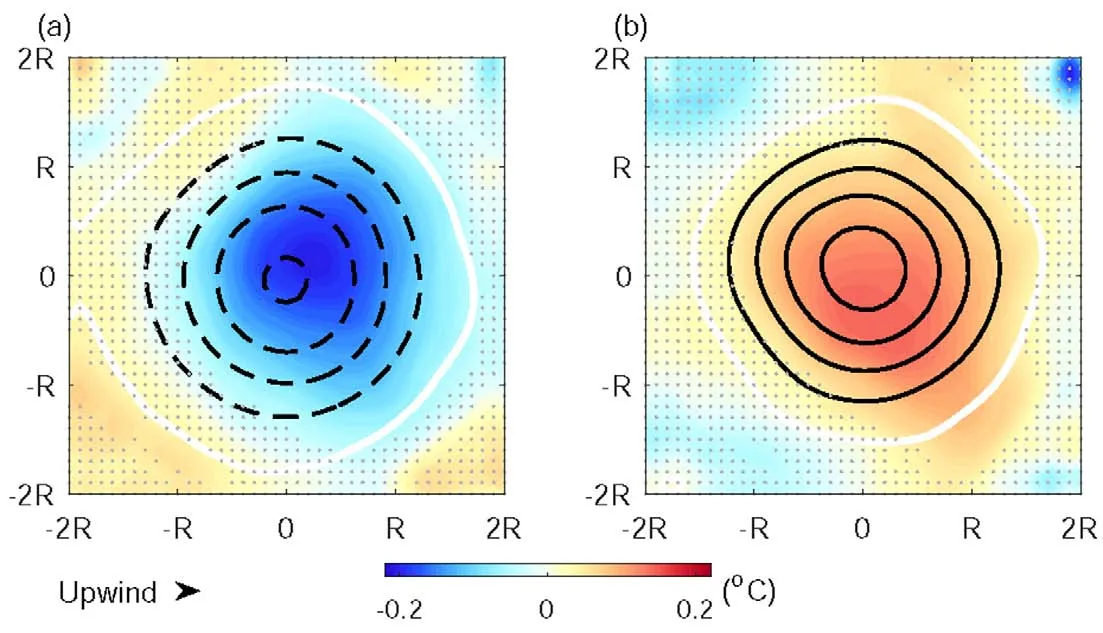
Fig.2.Mean composite maps of SLA(contours)and SST anomaly(colors)for(a)cyclonic and(b)anticyclonic eddies.Pre fi ltered satellite-derived data corresponding to 237 cyclonic and 201 anticyclonic eddies in the SCS during 2000 to 2012 were averaged.The scale of both axes denotes the normalized distance(2R for twice the eddy radius)from the eddy center in each direction.The x-axis is aligned along the background wind direction,as indicated by the arrow.The SLA contour intervals are 2.5 cm.The white contour indicates the zero line,and the dashed lines(solid lines)represent negative(positive)values.Anomalies in areas without dots are statistically di ff erent from zero at the 95%con fi dence level,based on the t-test.For quality-control purposes,if more than 30%of the samples were unavailable in one grid,the grid is also dotted.

Fig.3.Composite maps of the mean SST anomaly(contours;interval:0.1◦C;white contour,0◦C;dashed lines,negative values;solid lines,positive values)together with the(a,e)SHF anomaly(colors;positive upward),(b,f)LHF anomaly(colors;positive upward),(c,g)sea–air temperature di ff erence anomaly(colors),and(d,h)evaporation rate anomaly(colors):(a–d)averaged cyclonic eddies;(e–h)averaged anticyclonic eddies.
3.2.2.Composite of turbulent heat fl uxes
Turbulent heat fl ux is the principal connection between the ocean and the atmosphere.The composite maps of the mean SHF(positive upward)anomaly show a negative SHF center coincides with the cold eddy(Fig.3a)and a positive anomaly center is located in the south of the warm eddy(Fig.3e).LHF anomalies coincide well with the eddy centers,with a negative LHF anomaly over the cold eddy(Fig.3b)and a positive LHF anomaly over the warm eddy(Fig.3f).The composite SHF and LHF anomalies indicate the ocean obtains heat from the atmosphere over the cold eddy and loses heat to the atmosphere over the warm eddy.Quantitatively,the maximum LHF anomalies(−5.95 W m−2for cold eddies and 2.3 W m−2for warm eddies)are larger than the SHF anomalies(−1.04 W m−2for cold eddies and 0.54 W m−2for warm eddies).
Anomalous turbulent heat fl uxes triggered by SST anomalies are essential to the physical response of the atmosphere to mesoscale eddies.As the SHF is proportional to the air–sea temperature di ff erence and the LHF is proportional to the evaporation rate,the composite maps of the air–sea temperature di ff erence(Figs.3c and g)and evaporation rate(Figs.3d and h)have the same patterns as the heat fl uxes.As the air–sea temperature di ff erence can re fl ect the atmospheric stability,thenegative(positive)seaminusairtemperaturedifference anomaly in Fig.3c(Fig.3g)indicates the stability is intensi fi ed(weakened)over the cold(warm)eddy.Moreover,eddy-induced evaporation rate anomalies(Figs.3d and h)also represent the changes of atmospheric stability.More stable strati fi cation over the cold eddy decelerates the evaporation rate,and vice versa.In addition,extra heating corresponding to turbulent heat fl ux anomalies might change the SLP as well.Ultimately,the change in both the SLP and atmospheric stability might a ff ect the near-surface wind speed through the mechanisms mentioned above.
3.2.3. Composite wind speed,divergence and vorticity anomalies
Synchronous variations of SST and sea surface wind are crucial to the depiction of mesoscale ocean forcing.As expected,surface winds decelerate over the cold eddy(Fig.4a)and accelerate over the warm eddy(Fig.4b).The negative wind speed anomaly,with a minimum value of−0.19 m s−1,matches well with the cold eddy.Likewise,the positive wind speed anomaly,with a maximum value of 0.11 m s−1,is located over the warm eddy,with little phase shift.The nearly in-phase relationship between the wind and SST anomaly favors the vertical mixing mechanism for both cold and warm eddies.It is worth noting that the phase relationship between the SST and the surface wind speed anomaly is robust,i.e.,it is una ff ected by eddy strength.
The surface wind anomalies over the mesoscale eddies have further e ff ects on horizontal divergence and vorticity.In Fig.4b,surface fl ows converge on the upstream of the cold eddy and diverge on the downstream,forming a dipole pattern.A similar north–south dipole vorticity anomaly pattern is also obvious for the cold eddy(Fig.4c).To explain these dipole features,it is considered that the background wind blows from left to right;thus,convergent and divergent centers of the surface wind occur on the two sides of the eddy along the wind direction.Meanwhile,anticyclonic and cyclonic wind shear forms to the north and to the south of the eddy,perpendicular to the background wind.From this,it is evident that the in-phase relationship between the wind anomaly and the cold eddy is the fundamental cause of the dipole pattern.Therefore,the dipole pattern in the fi eld of anomalous divergence for the cold eddy also supports the vertical mixing mechanism.

Fig.4.Composite maps of the mean surface(a,d)wind speed anomaly,(b,e)divergence anomaly,and(c,f)vorticity anomaly:(a–c)averaged cyclonic eddies;(d–f)averaged anticyclonic eddies.
For the warm eddy,a single convergence center is located in the eddy center,with several surrounding centers of divergence(Fig.4e),representing a monopole pattern.It is more sensible to attribute the monopole convergence core to a depression over the warm eddy,which suggests the pressure adjustment mechanism is most appropriate in this context.Furthermore,themostapparentfeatureofthecompositevorticity anomalyforwarmeddies(Fig.4f)isananticyclonicareacentered on the warm eddy,which corresponds to the divergence area seen in Fig.4e.
In terms of the composite surface wind speed,divergence and vorticity fi elds,the vertical mixing mechanism is dominant for cold eddies,while for warm eddies the pressure adjustment mechanism is equally important.One possible explanationforthisdi ff erenceisthattheSCS ispartof the Indo-Paci fi c warm pool;warm eddies induce weaker SST anomalies than cold eddies(Fig.2),subsequently creating less of an air–sea temperature di ff erence,whereby their impact on the vertical mixing is limited.
3.2.4. Composite precipitation,water vapor and cloud liquid water
Both anomalous surface heating and modi fi cation of the local circulation might change the characteristics of precipitation,atmospheric water vapor,and cloud over mesoscale eddies.In Fig.5a,the cold eddy is sandwiched between two parallel rain bands with opposite signs and northwest–southeast alignment.The positive rain band is located on the left of the cold eddy,which is coincident with the convergence center upstream of the eddy seen in Fig.4b.The negative rain band corresponds to the divergence center and anticyclonic area(refer to Figs.4b and c).Both rain anomaly bands are statistically signi fi cant.For the warm eddy(Fig.5d),positive rain anomalies within the eddy are too small to pass the signi fi cance test.The areas of negative precipitation anomaly surrounding the eddy center are the most prominent feature,which are related to the descending branch in Fig.4e.
TherainrateanomalyrelatedtoeddiesintheSCSreaches 1–2 × 10−2mm h−1,which is comparable to the Kuroshio Extension region[1.5 × 10−2mm h−1(Ma et al.,2015)]and larger than the Southern Ocean[4±1×10−3mm h−1(Frenger et al.,2013)].The eddy-induced SST anomaly in both the Kuroshio Extension region and the Southern Ocean is 0.6◦C and 0.5◦C,respectively,much bigger than the SCS(0.2◦C),which might be expected to cause greater precipitation.However,the SCS is located within the monsoon region,where the atmosphere is much moister than the Southern Ocean(south of 30◦S).Furthermore,the SCS is near the region of the subtropical high and,therefore,the relatively smaller SST anomalies in the SCS generate comparable precipitation anomalies.In Figs.5b and e,eddy-induced columnar cloud liquid water anomalies exhibit the same spatial features as the precipitation anomalies,where negative(positive)cloud water anomalies are coincident with areas of less(more)precipitation.
In addition to precipitation and cloud anomalies,the features of columnar water vapor also re fl ect the in fl uence of mesoscale eddies on the entire atmosphere.For cold eddies,the negative columnar water vapor anomaly occurs over the eddy core(Fig.5c),whereas for warm eddies several positive anomaly centers are found within and around the warm eddy(Fig.5f).As is known,both surface heating and convergence transport can modify columnar water vapor.Comparison of the spatial pattern of the columnar water vapor anomaly(Figs.5c and f)with the divergence(Figs.4b and e)and heat fl ux(Figs.3a,b,e and f)anomalies shows the water vapor matches better with heat fl ux.Therefore,it is supposed that the thermodynamic process of mesoscale eddies in the SCS is more e ff ective than the dynamic process in changing columnar water vapor.
3.3.Quantitative descriptions of the coupling between eddies and atmospheric anomalies
To quantify the atmospheric responses to mesoscale eddies in the SCS statistically,the explained variations of atmospheric anomalies associated with eddies were calculated(Table 1).Cyclonic eddies explain 4.9%of the variance in the SST,while for anticyclonic eddies the value is 3.1%.That means the sea surface cooling induced by cyclonic eddies is more obvious than the surface warming caused by anticyclonic eddies in the SCS.In this case,atmospheric responses to cyclonic eddies are more signi fi cant in comparison to anticyclonic eddies.The explained variation of surface wind speed is 6%and 5.3%for cyclonic and anticyclonic eddies,respectively.In addition,5%–7%of the perturbations of LHF,SHF,and evaporation rate can be explained by mesoscale eddies.However,anomalous precipitation and columnar water vapor represent only 3%and 1%of the natural variability,respectively,which suggests the impact of eddies on the upper-level atmosphere is limited in the SCS.
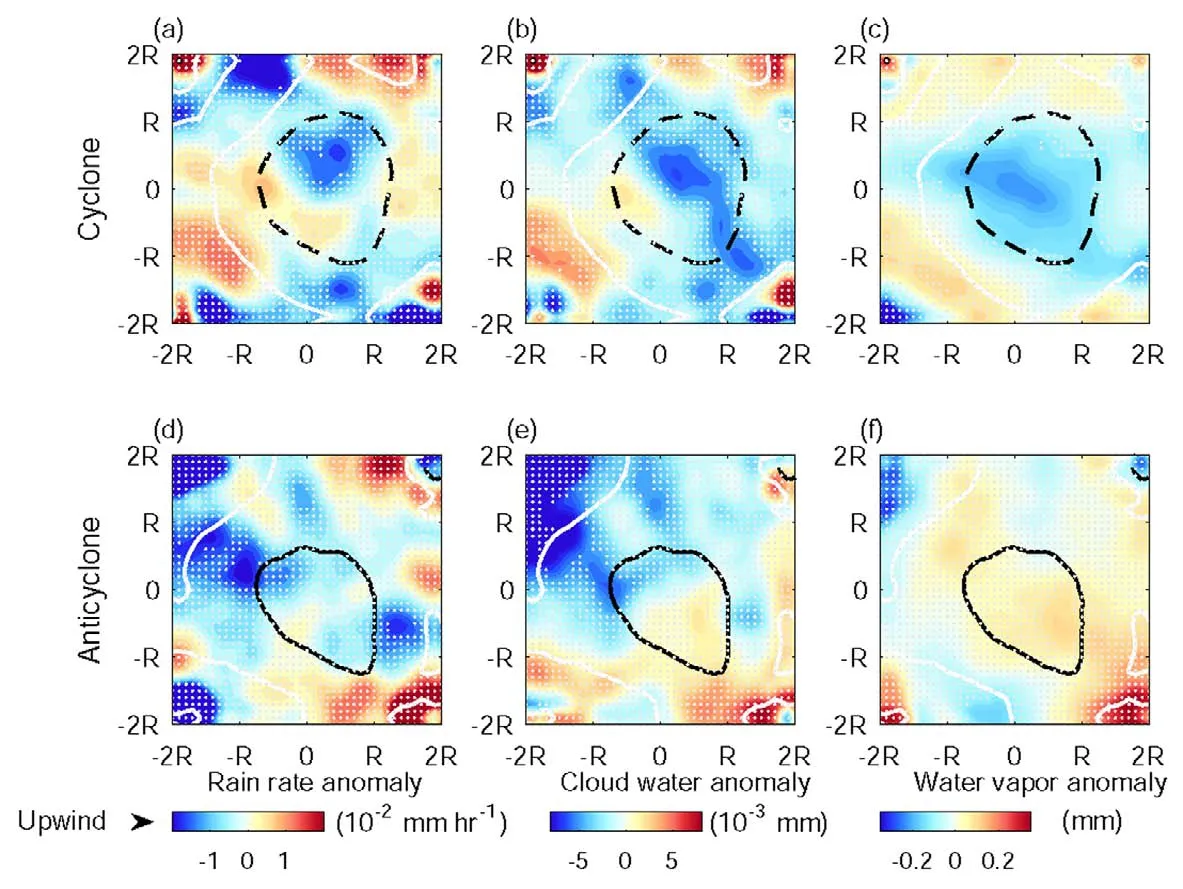
Fig.5.Composite maps of the mean(a,d)rain rate anomaly(colors),(b,e)columnar cloud liquid water anomaly(colors),and(c,f)columnar water vapor anomaly(colors):(a–c)averaged cyclonic eddies;(d–f)averaged anticyclonic eddies.
Composite maps only reveal the mean state of the atmospheric response to mesoscale eddies.Therefore,scatterplots of SST anomalies versus atmospheric anomalies were produced to infer the atmospheric responses to varying SST anomalies.Based on the 438 eddy samples averaged for the composite analysis,the maximum SST anomalies within the eddy radius and the corresponding atmospheric anomalies in each sample were dotted and binned thereafter.First,if the intensity of an ocean eddy is measured by the SLA,then Fig.6a shows stronger eddies are corresponding to the larger SST anomalies(r2=0.96)in the SCS.Using the least-squares estimation,the linear relationship between the SLA and SST anomaly is signi fi cant;a 17.28 cm increase in the SLA would raise the maximum SST anomaly by 1◦C.Similar to previous studies on the Southern Ocean and the Kuroshio Extension regions(Frenger et al.,2013;Ma et al.,2015),obvious linear relationships were found to exist between the SST anomaly and atmospheric anomalies in the SCS.In addition,the slopes of the fi tting curves were used to denote the strength of the coupling of the two variables.In agreement with the composite analysis(Figs.4a and d),the surface wind speed increases with the SST anomaly(r2=0.96;Fig.6b),and the coupling strength is 0.79 m s−1◦C−1,which is stronger than the Southern Ocean and the Kuroshio Extension(∼ 0.4 m s−1◦C−1)(Frenger et al.,2013;Ma et al.,2015).In Fig.6c,the correlation coefficient between the SST and turbulent heat fl uxes anomalies is 0.99;a 1◦C SST anomaly might provide additional heating(cooling)of 29.19 W m−2.The temperature di ff erence between the sea surface and the air is also proportional to the SST anomaly(r2=0.99;Fig.6d)and the coupling strength is 3.41◦C◦C−1,which indicates atmospheric stability changes linearly with SST anomalies over mesoscale eddies.

Table 1.Eddy-induced anomalies of SST,wind speed,latent and sensible heat fl uxes,evaporation rate,rain rate and columnar water vapor in the SCS.Maximum(minimum)values plus or minus one con fi dence interval(CI)and the explained variation(EV)of each variable are given for cyclonic and anticyclonic eddies∗.
Through Table 1 and the scatterplots above,results show thatthestandarddeviationsofatmosphericanomaliesaccording to mesoscale eddies in the SCS are larger than those in the Southern Ocean(Frenger et al.,2013),in agreement with Sun et al.(2016).This is because a fair amount of eddies are active along the coastline,where complex topography makes the sizes,shapes and spatial distributions of the atmospheric anomalies tailored for di ff erent eddies.In addition,seasonal variations of basin-scale SST(Liu et al.,2005)and the eddy seasonal variations(Du et al.,2016)may also in fl uence the variability of atmospheric responses.It is worth noting that the error of satellite observations used in this study may be comparable to the anomaly related to individual eddies.For example,the mean bias error of the OI SST,OA Flux,blended wind speed and TRMM rain rate is about 0.4◦C,7.4 W m−2,0.2 m s−1and 2 mm d−1,respectively(Yu et al.,2008;Scheel et al.,2011;Peng et al.,2013).Despite the potential bias,our results are signi fi cant being derived from a large number of eddies.
4.Model study on the eddy dipole o ffeastern Vietnam
Discussions on the potential mechanisms for atmospheric manifestations based on phase relationships are not sufficiently detailed.This is because phase relationships might be a ff ected by the atmospheric background and di ff erences between original satellite-derived datasets(Spall,2007;Small et al.,2008;Byrne et al.,2015).Therefore,a case study based on a model simulation is used here to clarify the potential mechanisms further.
4.1. Eddy dipole in 2004 and its e ff ect on the atmosphere
An eddy dipole,comprising a cold eddy north of the coastal jet o ffthe central Vietnam coast and a warm eddy south of the jet,is a common feature in the southwestern SCS during the summer monsoon period(Chen et al.,2010;Hu et al.,2011).The case used here formed on 1 June 2004 and persisted for about 30 days.Two tropical depressions had passed by the eddy area.In fl uenced by these tropical depressions,eddy-related SSTs and surface wind speeds were obscured during the period 4–11 June.Furthermore,the developments of the two eddies were not synchronous during the lifetime of the eddy dipole.Thus,the period of study here was 16–21 June,when the dipole pattern was vigorous and the in fl uences of additional weather systems were eliminated.As shown in Fig.7a,the eddy dipole is clearly visualized by two SLA centers of opposite sign.The negative SLA with cyclonic currents denotes the cyclonic mesoscale eddy,and the anticyclonic mesoscale eddy with positive SLA and anticyclonic currents is to its south.Under the background southwesterly monsoon,SST anomalies(about−0.3◦C for the cold eddy and about 0.5◦C for the warm eddy)related to the mesoscale eddies are discernible in the original SST fi eld(Fig.7b).It should be noted that the variation between the SST and surface wind speed over the eddy dipole was simultaneous and consecutive.
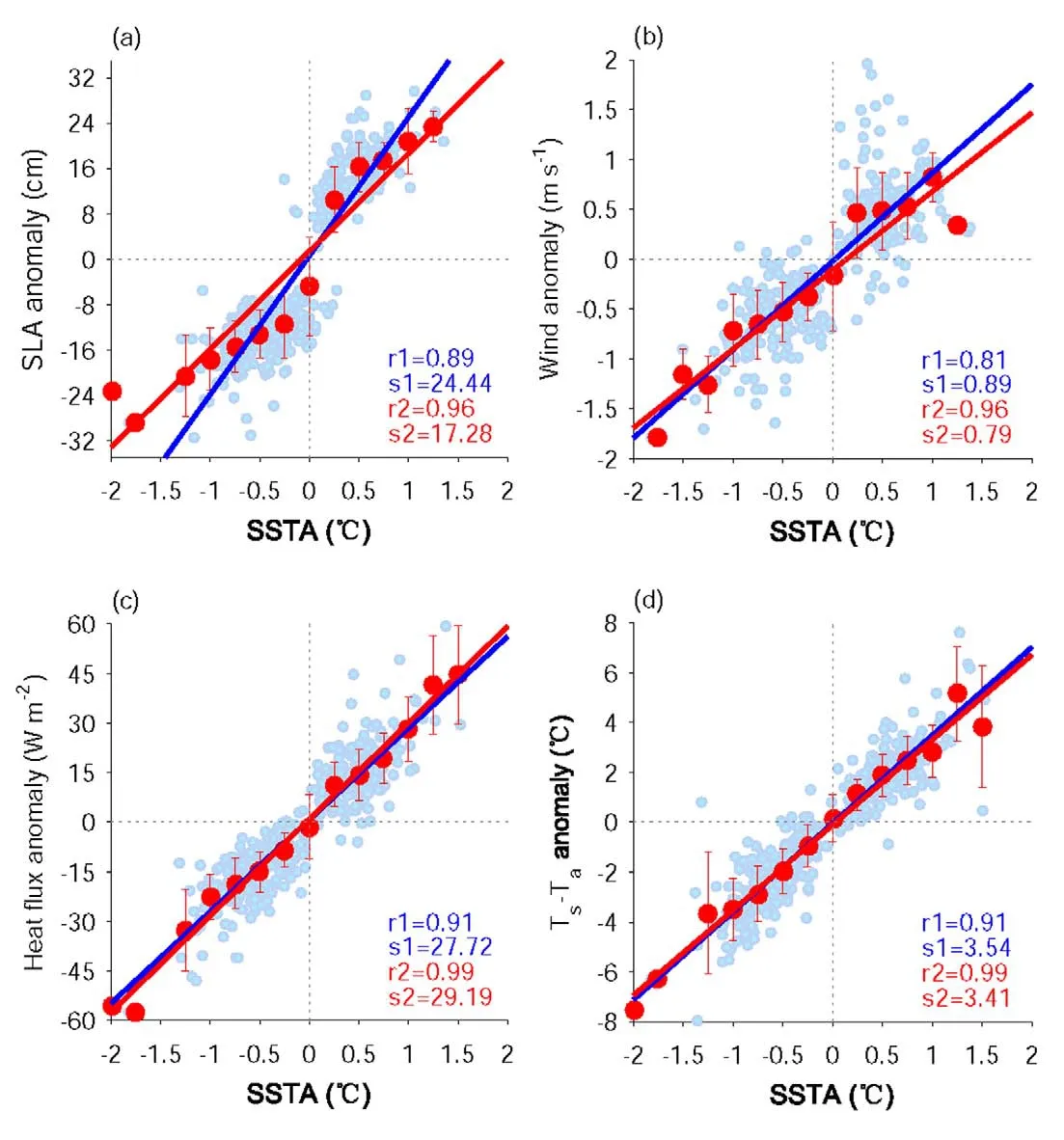
Fig.6.Scatterplotsoftheeddy-inducedSSTanomaly(SSTA)versusthe(a)SLAand(b–d)atmosphericanomalies including the(b)wind speed,(c)turbulent heat fl uxes and(d)sea-minus-air temperature di ff erence.Unbinned data(blue dots)represent the total of 438 eddy samples averaged in the composite analysis.The maximum SST anomalies within the eddy radius and the corresponding atmospheric anomalies in each sample were selected.Binned data(red dots with 0.25◦C intervals)with error bars denote the mean value and the ±1 standard deviation.The correlation coefficients(r1 and r2)and the slopes(s1 and s2)of the least-squares fi t to the unbinned and binned data are shown as blue and red lines.All values are signi fi cant at the 99%con fi dence level.
4.2.Model experiments
The model ran for seven days for the period 15–21 June 2004.A control run with real daily(MW_IR)OI SSTs(the RSR run)and a sensitivity run with smoothed SSTs(the SSR run)were performed to isolate the eddy signals.In the SSR run,the original SST fi elds were fi ltered through a spatial(Loess) fi lter to retain signals larger than 4.5◦latitude×4.5◦longitude,and then a smooth fi lter(10-point moving average)was adopted in the SST fi elds,meaning no more mesoscale features existed in the SSR run.The SST fi elds were updated at each time step for all simulation processes.The simulation results for the nested domain,outputted every 12 h from 16 June,were used in the following analysis.
4.3.Primary mechanism responsible for atmospheric anomalies
Using the realistic SST fi eld,the atmospheric responses to the eddy dipole were successfully rendered in RSR.Validation against satellite observations(Figs.8a and b),the sim-ulated mean surface wind anomaly(±0.5 m s−1)and total turbulence heat fl ux anomaly(±25 W m−2)are coincident with the eddy dipole(Figs.8c and d).In addition to the spatial(Loess) fi lter used in RSR and the observational data(Figs.8a–d),the eddy impact could be extracted from the di ff erence between RSR and SSR without applying any fi lter(Figs.8e and f).As shown in Figs.8e and f,the wind speed and turbulence heat fl ux are altered because of the eddy dipole.
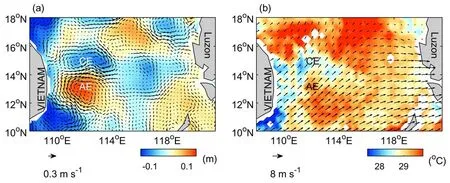
Fig.7.Satellite-observed(a)SLA(colors)and surface geostrophic currents(a)(vectors),and(b)SST(colors)and sea surface wind(vectors),averaged during 16–21 June 2004.The labels“CE”and“AE”represent cyclonic eddy and anticyclonic eddy,respectively.
Anomalous heat fl uxes might change the turbulence kinetic energy(TKE)through buoyancy;therefore,TKE was outputted to characterize changes in turbulence intensity over the mesoscale eddies. The eddy-induced TKE anomaly(RSR minus SSR)is negative(positive)over the cold(warm)eddy,whereturbulenceisweakened(strengthened)withinthe boundary layer(Fig.9).Based on the vertical mixing mechanism,a negative TKE anomaly over the cold eddy might obstruct vertical momentum transport.Therefore,higher momentums are isolated in the upper layer(above 200 m),leading to negative wind speed anomalies near the surface and positive anomalies in the upper layer over the cold eddy(Fig.9).Conversely,enhanced turbulent mixing over the warm eddy leads to increased downward momentum transport,which accelerates the surface wind(Fig.9).The vertical fl uxes of horizontal momentumcan be represented by the friction velocityIn Fig.10a,the spatial distribution of the u∗anomaly related to the mesoscale eddies is also presented as a dipole pattern.It is evident that the vertical momentum fl ux is intensi fi ed over the warm eddy and weakened over the cold eddy,recon fi rming the importance of the vertical mixing mechanism.However,in Fig.10b,the SLP over the eddy dipole is also changed,showing a rise of about 0.05 hPa over the cold eddy and a decrease of about 0.03 hPa over the warm eddy,which suggests additional involvement of the pressure adjustment mechanism.
To explain the variation of surface wind over the eddy dipole further,the dominant terms in the atmospheric horizontal momentum equations were investigated.In the WRF model,the horizontal momentum equations can be written as:

Variables U and V are de fi ned as U=(µu)/m and V=(µv)/m,where u and v are the horizontal wind components in the x and y directions,respectively,m is the map-scale factor,andµis the mass of dry air per unit area within a model column.Here,is the three-dimensional coupled vector ve-W is the coupled vertical component of velocity],η represents the terrain-following pressure vertical coordinate,and FU,mixand FV,mixrepresent the vertical mixing.The other parameters are commonly used variables:t is time;p is pressure;f is the Coriolis parameter;ϕ is the geopotential;and α and αdrepresent the inverse density of full parcel density and dry density,respectively[for further details,see Skamarock et al.(2008)].In Eqs.(1)and(2),the terms on the left represent the horizontal momentum tendencies.The fi rst term on the right-hand side is the atmospheric advection term;the second and third terms represent the atmospheric pressure gradient force;the fourth term is the Coriolis force;and the fi nal term is the atmospheric vertical mixing term(the curvature and horizontal di ff usion terms are omitted here).

Fig.8.Spatial distributions of eddy-induced(a,c,e)surface wind speed anomalies and(b,d,f)turbulence heat fl ux anomalies:(a,b)spatially fi ltered satellite observations;(c,d)spatially fi ltered RSR data;(e,f)di ff erences between RSR and SSR.The spatial(Loess) fi lter with a half-width of 4.5◦was used in(a–d).SST anomalies of 0.2◦C(solid line)and −0.2◦C(dashed line)are superposed on each subplot to identify the warm and cold eddies,respectively.All variables were averaged for 16–21 June 2004.
The vector di ff erences of the momentum budget terms between RSR and SSR are shown in Fig.11.Against the background of the southwesterly monsoon(Fig.7b),a wind reduction is represented as anomalous northeasterly winds;thus,the northwestward Coriolis force terms located over the cold eddy are reasonable(Fig.11b).Contrary to the cold eddy,anomalous southeastward Coriolis force terms indicate anomalous southwesterly wind,indicating a wind increase over the warm eddy.Compared with the Coriolis force term,the advection term is much larger in the RSR minus SSR fi eld(Fig.11c).Horizontal advection is convergent over the cold eddy and divergent over the warm eddy.In contrast to the advection term,the pressure gradient forces term is divergent in the cold-eddy area and convergent in the warm-eddy area(Fig.11d).This is entirely reasonable because the SLP increases and decreases over the cold and warm eddies,respectively,as noted in respect to Fig.10b.The additional pressure gradient force is opposite(homodromous)to the background wind on the upwind(downwind)side of the cold(warm)eddy,which fi nally leads to surface wind deceleration(ac-celeration).The vertical mixing term in Fig.11e is almost opposite to the anomalous wind vector and it behaves as a drag term in the MABL.For clearer recognition of the contribution of each term in the momentum equation to the surface wind anomaly,their scalar di ff erences between RSR and SSR are also depicted in each subplot.First,the Coriolis force is proportional to the wind speed and,therefore,the decreasing(increasing)wind speed over the cold(warm)eddy is represented as the negative(positive)Coriolis force in Fig.11b.Second,the advection term accelerates the surface wind upstream of the cold eddy and decelerates the wind speed on the downstream side(Fig.11c).Similarly,the e ff ects of the pressure gradient force on the surface wind are located mainly on the edges of the mesoscale eddies(Fig.11d).The anomalous mixing term in Fig.11e presents a dipole pattern,which is decreased and increased over the cold and warm eddies,respectively,just as expected based on the vertical mixing mechanism.Finally,the eddy-induced anomalies for each momentum term across the eddy dipole are compared in Fig.11a.The pressure gradient force term and the advection term are largest near the eddy boundaries and they are balanced with each other.The vertical mixing term is bigger than the pressure gradient force term,and it mainly a ff ects the surface wind just over the eddy center.Thus,although both vertical mixing and SLP anomalies are responsible for the wind anomalies,the mixing term is more e ff ective,especially over the eddy dipole.Synthesizing the above analysis,a schematic map of the atmospheric response to the eddy dipole is presented in Fig.12.

Fig.9.Vertical cross sections of horizontal wind speed(colors)and TKE(lines)anomalies from the RSR minus SSR di ff erences along the gray line shown in Fig.8e.Gray solid lines indicate the range of the warm eddy[(12.9◦N,111.5◦E)to(14.0◦N,112.6◦E)]and the cold eddy[(14.0◦N,112.6◦E)to(15.0◦N,113.7◦E)].Averaging period:16–21 June 2004.
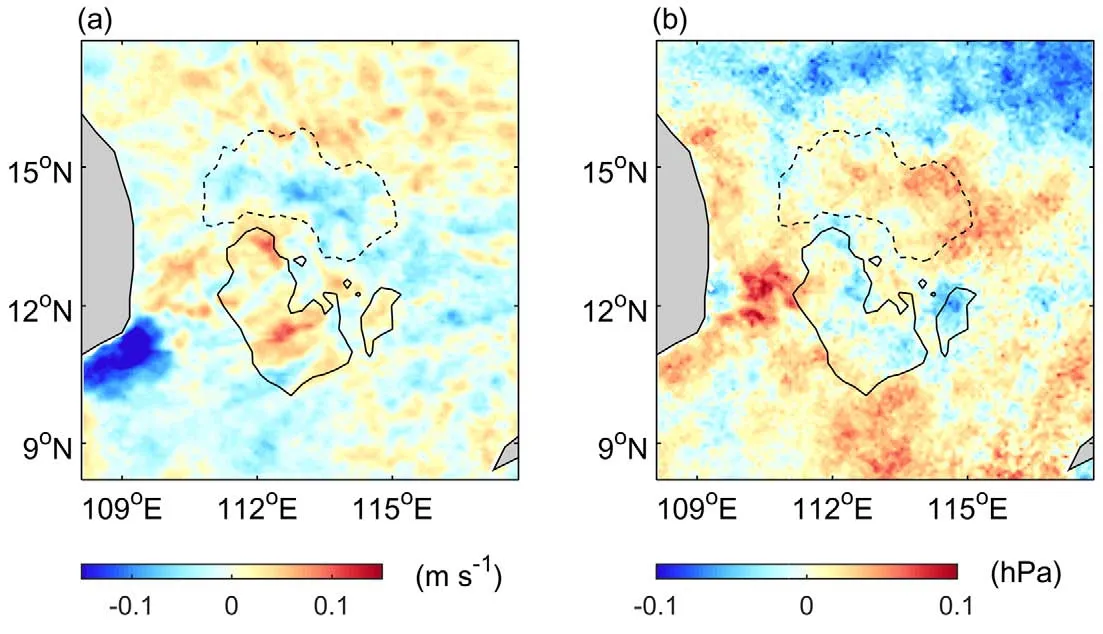
Fig.10.Spatial distribution of simulated(a)friction velocity(colors)and(b)SLP(colors)di ff erences between RSR and SSR.
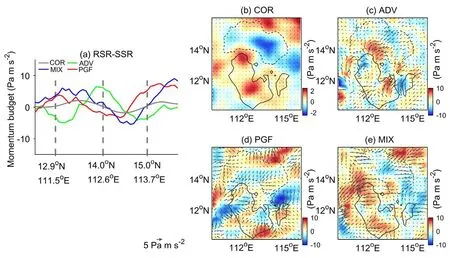
Fig.11.(a)Curves of anomalous(RSR minus SSR)momentum budget terms along the gray line shown in Fig.8e.Gray dotted lines indicate the ranges of the warm and cold eddies.(b–e)Spatial distribution of vector and scalar di ff erences of momentum budget terms[(b)Coriolis force;(c)advection;(d)pressure gradient force;(e)vertical mixing]between RSR and SSR,at the second(∼ 12 m)level,averaged for 16–21 June 2004.
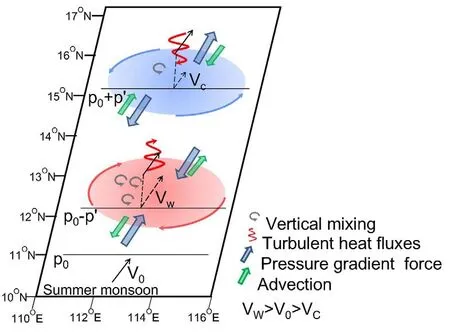
Fig.12.Schematic diagram of the impact of mesoscale ocean eddies on the atmosphere for an eddy dipole in the southwestern SCS.Cold(blue)and warm(red)SST is corresponding to the cyclonic(north of 14◦N)and anticyclonic eddy(south of 14◦N),respectively.Downward(upward)turbulent heat fl ux anomalies over the cyclonic(anticyclonic)eddy tend to cool(warm)the MABL.This leads to an increment(reduction)in the stability of the MABL and abatement(intensi fi cation)of the vertical mixing over the cold(warm)eddy.Subsequently,the vertical wind shear is increased(decreased)and the near surface wind decelerates(accelerates)over the cold(warm)eddy.In addition,the heating anomaly makes the SLP higher(lower)over the cold(warm)eddy.The extra pressure gradient force is opposite(homodromous)to the background wind on the upwind side and homodromous(opposite)on the downwind side.Meanwhile,the pressure gradient force is almost balanced by the horizontal advection on the edges of mesoscale eddies.Accordingly,the vertical mixing mechanism is dominant for wind anomalies over the eddy dipole;the pressure adjustment mechanism is responsible for wind anomalies on eddy edges.
5.Summary and discussion
This study examined the air–sea interaction processes related to mesoscale ocean eddies over the SCS.Through composite analyses of 438 mesoscale eddies that occurred during 2000–2012,the positive relationship between surface wind speed and SST is con fi rmed.Anomalous heating related to mesoscale eddies changes the stability of the MABL,and makes the wind speed decrease over cold eddies and increase over warm eddies.Eddy-induced wind anomalies result in anomalous divergence and vorticity,which ultimately result in anomalous precipitation.More than 5%of the total variance of heat fl uxes,sea surface wind,and evaporation rate is induced by mesoscale eddies.Furthermore,about 1%of columnar water vapor and 3%of precipitation anomalies can also be explained by such eddies.
The physical mechanisms of the atmospheric responses to mesoscale eddies were studied through dynamical diagnosis and modeling.Based on the composite analyses,wind anomalies over cold and warm eddies are almost co-located with the SST anomalies,which in combination with the signi fi cant changes in atmospheric stability(sea–air temperature di ff erence)represent the character of the vertical mixing mechanism.In addition,the dipole pattern of the divergence anomaly over cold eddies favors the vertical mixing mechanism as well.In contrast,the monopole pattern corresponding to the anomalous divergence over warm eddies suggests thepressureadjustmentmechanismalsoplaysaroleina ff ecting the atmosphere.The model study of an eddy dipole o ff eastern Vietnam showed that heat fl ux anomalies induced by mesoscale eddies lead to changes in TKE and friction velocity,indicating weak vertical momentum transport over cold eddies and intense vertical momentum transport over warm eddies.Anomalous momentum fl uxes ultimately result in changes in surface wind speed.Diagnosis of the atmospheric horizontal momentum equations suggested that surface wind anomalies are produced by the advection,pressure gradient force,and vertical mixing terms.Among them,the pressure gradient term is almost balanced by the advection term;thus,the vertical mixing term dominates the surface wind anomalies over the eddy dipole.
The present study focused on a systematic exposition of the imprint of mesoscale eddies on the atmosphere over the SCS.Recent studies have shown the surface wind response to mesoscale eddies in the SCS has regional diversity and seasonal variation(Chow and Liu,2012;Sun et al.,2016).In addition,atmospheric anomalies generated by mesoscale eddies might have feedback loops to the eddies themselves(McGillicuddy,2015;Seo et al.,2016).Therefore,more detailed studies on the e ff ects of eddies under di ff erent atmospheric and oceanic conditions should be undertaken.Combining in-situ observations of drifting buoys or fi eld cruises with a fully coupled atmosphere–ocean model would be helpful in obtaining conclusions that are more realistic and comprehensive.
Acknowledgements.This work was supported by the National Natural Science Foundation of China(Grant Nos.41675043 and 41375050).
REFERENCES
Bourras,D.,G.Reverdin,H.Giordani,and G.Caniaux,2004:Response of the atmospheric boundary layer to a mesoscale oceanic eddy in the Northeast Atlantic.J.Geophys.Res.,109,D18114,https://doi.org/10.1029/2004JD004799.
Brachet,S.,F.Codron,Y.Feliks,M.Ghil,H.Le Treut,and E.Simonnet,2012:Atmospheric circulations induced by a midlatitude SST front:A GCM study.J.Climate,25(6),1847–1853,https://doi.org/10.1175/JCLI-D-11-00329.1.
Byrne,D.,L.Papritz,I.Frenger,M.Mnnich,and N.Gruber,2015:Atmospheric response to mesoscale sea surface temperature anomalies:Assessment of mechanisms and coupling strength in a high-resolution coupled model over the South Atlantic.J.Atmos.Sci.,72(5),1872–1890,https://doi.org/10.1175/JAS-D-14-0195.1.
Chelton,D.,2013:Ocean-atmosphere coupling:Mesoscale eddy e ff ects.Nat.Geosci.,6(8),594–595,https://doi.org/10.1038/ngeo1906.
Chelton,D.B.,and S.-P.Xie,2010:Coupled ocean-atmosphere interaction at oceanic mesoscales.Oceanography,23(4),52–69,https://doi.org/10.5670/oceanog.2010.05.
Chelton,D.B.,M.G.Schlax,and R.M.Samelson,2011:Global observations of nonlinear mesoscale eddies.Progress in Oceanography,91(2),167–216,https://doi.org/10.1016/j.pocean.2011.01.002.
Chen,F.,and J.Dudhia,2001:Coupling an advanced land surfacehydrology model with the Penn State-NCAR MM5 modeling system.Part I:Model implementation and sensitivity.Mon.Wea.Rev.,129(4),569–585,https://doi.org/10.1175/1520-0493(2001)129<0569:CAALSH>2.0.CO;2.
Chen,G.X.,Y.J.Hou,and X.Q.Chu,2011:Mesoscale eddies in the South China Sea:Mean properties,spatiotemporal variability,and impact on thermohaline structure.J.Geophys.Res.,116(C6),https://doi.org/10.1029/2010JC006716.
Chen,G.X.,Y.J.Hou,Q.L.Zhang,and X.Q.Chu,2010:The eddy pair o ffeastern Vietnam:Interannual variability and impact on thermohaline structure.Cont.Shelf Res.,30(7),715–723,https://doi.org/10.1016/j.csr.2009.11.013.
Chen,L.J.,Y.L.Jia,and Q.Y.Liu,2017:Oceanic eddy-driven atmospheric secondary circulation in the winter Kuroshio Extension region.Journal of Oceanography,73(3),295–307,https://doi.org/10.1007/s10872-016-0403-z.
Chow,C.H.,and Q.Y.Liu,2012:Eddy e ff ects on sea surface temperature and sea surface wind in the continental slope region of the northern South China Sea.Geophys.Res.Lett.,39(2),L02601,https://doi.org/10.1029/2011GL050230.
Cleveland,W.S.,1979:Robust locally weighted regression and smoothing scatterplots.Journal of the American Statistical Association,74(368),829–836,https://doi.org/10.1080/01621459.1979.10481038.
Du,Y.Y.,D.Wu,F.Y.Liang,J.W.Yi,Y.Mo,Z.G.He,and T.Pei,2016:Major migration corridors of mesoscale ocean eddies in the south china sea from 1992 to 2012.J.Mar.Syst.,158,173–181,https://doi.org/10.1016/j.jmarsys.2016.01.013.
Fang,W.D.,G.H.Fang,P.Shi,Q.Z.Haung,and Q.Xie,2002:Seasonal structures of upper layer circulation in the southern South China Sea from in situ observations.J.Geophys.Res.,107,23-1–23-12,https://doi.org/10.1029/2002JC001343.
Frenger,I.,N.Gruber,R.Knutti,and M.Mnnich,2013:Imprint of Southern Ocean eddies on winds,clouds and rainfall.Nat.Geosci.,6,608–612,https://doi.org/10.1038/ngeo1863.
Gaube,P.,D.B.Chelton,R.M.Samelson,M.G.Schlax,and L.W.O’Neill,2015:Satellite observations of mesoscale eddyinduced Ekman pumping.J.Phys.Oceanogr.,45(1),104–132,https://doi.org/10.1175/JPO-D-14-0032.1.
Hausmann,U.,and A.Czaja,2012:The observed signature of mesoscale eddies in sea surface temperature and the associated heat transport.Deep-Sea Res.,70,60–72,https://doi.org/10.1016/j.dsr.2012.08.005.
Hayes,S.P.,M.J.McPhaden,and J.M.Wallace,1989:The in fl uence of sea-surface temperature on surface wind in the eastern equatorial Paci fi c:Weekly to monthly variability.J.Climate,2,1500–1506,https://doi.org/10.1175/1520-0442(1989)002<1500:TIOSST>2.0.CO;2.
Hong,S.Y.,and J.O.J.Lim,2006:The WRF single-moment 6-class microphysics scheme(WSM6).Korean Meteorological Society,42(2),129–151.
Hu,J.Y.,J.P.Gan,Z.Y.Sun,J.Zhu,and M.H.Dai,2011:Observed three-dimensional structure of a cold eddy in the southwestern South China Sea.J.Geophys.Res.,116(C5),https://doi.org/10.1029/2010JC006810.
Iacono,M.J.,J.S.Delamere,E.J.Mlawer,M.W.Shephard,S.A.Clough,and W.D.Collins,2008:Radiative forcing by long-lived greenhouse gases:Calculations with the AER radiative transfer models.J.Geophys.Res.,113(D13),https://doi.org/10.1029/2008JD009944.
Janji´c,Z.I.,1994:The step-mountain eta coordinate model:Further developments of the convection,viscous sublayer,and turbulence closure schemes.Mon.Wea.Rev.,122(5),927–945,https://doi.org/10.1175/1520-0493(1994)122<0927:TSMECM>2.0.CO;2.
Janji´c,Z.I.,2002:Nonsingular implementation of the Mellor–Yamada level 2.5 scheme in the NCEP Meso Model.NCEP Office Note,437,61 pp.
Lambaerts,J.,G.Lapeyre,R.Plougonven,and P.Klein,2013:Atmospheric response to sea surface temperature mesoscale structures.J.Geophys.Res.,118(17),9611–9621,https://doi.org/10.1002/jgrd.50769.
Lindzen,R.S.,andS.Nigam,1987:Ontheroleofseasurfacetemperaturegradientsinforcinglow-levelwindsandconvergence in the tropics.J.Atmos.Sci.,44,2418–2436,https://doi.org/10.1175/1520-0469(1987)044<2418:OTROSS>2.0.CO;2.
Liu,Q.Y.,S.P.Xie,L.J.Li,and N.A.Maximenko,2005:Ocean thermal advective e ff ect on the annual range of sea surface temperature.Geophys.Res.Lett.,32(24),L24604,https://doi.org/10.1029/2005GL024493.
Ma,J.,H.M.Xu,and C.M.Dong,2016:Seasonal variations in atmospheric responses to oceanic eddies in the Kuroshio Extension.Tellus A,68,31563,https://doi.org/10.3402/tellusa.v68.31563.
Ma,J.,H.M.Xu,C.M.Dong,P.F.Lin,and Y.Liu,2015:Atmosphericresponses to oceanic eddies in the Kuroshio Extension region.J.Geophys.Res.,120(13),6313–6330,https://doi.org/10.1002/2014JD022930.
McGillicuddy Jr.,D.J.,2015:Formation of Intrathermocline lenses by eddy-wind interaction.J.Phys.Oceanogr.,45,606–612,https://doi.org/10.1175/JPO-D-14-0221.1.
Messager,C.,and S.Swart,2016:Signi fi cant atmospheric boundary layer change observed above an Agulhas current warm cored eddy.Advances in Meteorology,2016,https://doi.org/10.1155/2016/3659657.
Nonaka,M.,and S.-P.Xie,2003:Covariations of sea surface temperature and wind over the Kuroshio and its extension: Evidence for ocean-to-atmosphere feedback.J.Climate,16,1404–1413,https://doi.org/10.1175/1520-0442(2003)16<1404:COSSTA>2.0.CO;2.
O’Neill,L.W.,D.B.Chelton,and S.K.Esbensen,2010:The e ff ects of SST-induced surface wind speed and direction gradients on midlatitude surface vorticity and divergence.J.Climate,23(2),255–281,https://doi.org/10.1175/2009 JCLI2613.1.
Peng,G.,H.M.Zhang,H.P.Frank,J.R.Bidlot,M.Higaki,S.Stevens,and W.R.Hankins,2013:Evaluation of various surface wind products with oceansites buoy measurements.Wea.Forecasting,28(6),1281–1303,https://doi.org/10.1175/WAF-D-12-00086.1.
Putrasahan,D.A.,A.J.Miller,and H.Seo,2013:Isolating mesoscale coupled ocean–atmosphere interactions in the Kuroshio Extension region.Dyn.Atmos.Oceans,63,60–78,https://doi.org/10.1016/j.dynatmoce.2013.04.001.
Sabu,P.,J.V.George,N.Anilkumar,R.Chacko,V.Valsala,and C.T.Achuthankutty,2015:Observations of watermass modi fi cation by mesoscale eddies in the subtropical frontal region of the Indian Ocean sector of southern ocean.Deep-Sea Res,118,152–161.
Scheel,M.L.M.,M.Rohrer,C.Huggel,D.S.Villar,E.Silvestre,and G.J.Hu ff man,2011:Evaluation of TRMM multisatellite precipitation analysis(TMPA)performance in the central Andes region and its dependency on spatial and temporal resolution.Hydrology and Earth System Sciences Discussions,15(8),2649–2663,https://doi.org/10.5194/hess-15-2649-2011.
Seo,H.,A.J.Miller,and J.R.Norris,2016:Eddy–wind interaction in the California current system:Dynamics and impacts.J.Phys.Oceanogr.,46(2),439–459,https://doi.org/10.1175/JPO-D-15-0086.1.
Skamarock,W.C.,and Coauthors,2008:A description of the advanced research WRF version 3.NCAR Technical Note NCAR/TN-475+STR,pp.1–113,https://doi.org/10.5065/D68S4MVH.
Skyllingstad,E.D.,D.Vickers,L.Mahrt,and R.Samelson,2007:E ff ects of mesoscale sea-surface temperature fronts on the marine atmospheric boundary layer.Bound.-Layer Meteor.,123(2),219–237,https://doi.org/10.1007/s10546-006-9127-8.
Small,R.J.,and Coauthors,2008:Air-sea interaction over ocean fronts and eddies.Dyn.Atmos.Oceans,45(3–4),274–319,https://doi.org/10.1016/j.dynatmoce.2008.01.001.
Spall,M.A.,2007:Midlatitude wind stress–sea surface tempera-ture coupling in the vicinity of oceanic fronts.J.Climate,20,3785–3801,https://doi.org/10.1175/JCLI4234.1.
Sun,S.W.,Y.Fang,B.C.Liu,and Tana,2016:Coupling between SST and wind speed over mesoscale eddies in the South China Sea.Ocean Dynamics,66(11),1467–1474,https://doi.org/10.1007/s10236-016-0993-4.
Tiedtke,M.,1989:A comprehensive mass fl ux scheme for cumulus parameterization in large-scale models.Mon.Wea.Rev.,117(8),1779–1816,https://doi.org/10.1175/1520-0493(1989)117<1779:ACMFSF>2.0.CO;2.
Wallace,J.M.,T.P.Mitchell,and C.Deser,1989:The infl uence of sea-surface temperature on surface wind in the eastern equatorial Paci fi c:Seasonal and interannual variability.J.Climate,2,1492–1499,https://doi.org/10.1175/1520-0442(1989)002<1492:TIOSST>2.0.CO;2.
Wang,C.Z.,and J.Picaut,2004:Understanding ENSO physics-a review.Earth’s Climate:The Ocean-Atmosphere Interaction.AGU,Washington,D.C.,21–48,https://doi.org/10.1029/147GM02.
Wang,G.H.,J.L.Su,and P.C.Chu,2003:Mesoscale eddies in the South China Sea observed with altimeter data.Geophys.Res.Lett.,30(21),2121,https://doi.org/10.1029/2003GL018532.
White,W.B.,and J.L.Annis,2003:Coupling of extratropical mesoscale eddies in the ocean to westerly winds in the atmospheric boundary layer.J.Phys.Oceanogr.,33,1095–1107,https://doi.org/10.1175/1520-0485(2003)033<1095:COEMEI>2.0.CO;2.
Xie,S.-P.,2004:Satellite observations of cool ocean–atmosphere interaction.Bull.Am.Meteor.Soc.,85,195–208,https://doi.org/10.1175/BAMS-85-2-195.
Xiu,P.,F.Chai,L.Shi,H.J.Xue,and Y.Chao,2010:A census of eddy activities in the South China Sea during 1993–2007.J.Geophys.Res.,115(C3),https://doi.org/10.1029/2009 JC005657.
Yu,L.,X.Jin,and R.A.Weller,2008:Multidecade global fl ux datasets from the objectively analyzed air-sea fl uxes(oa fl ux)project:latent and sensible heat fl uxes,ocean evaporation,and related surface meteorological variables.Woods Hole Oceanographic Institution,OAFlux Project Tech.Rep.OA-2008-01,64 pp.
Zhang,C.D.,2005:Madden-Julian oscillation.Rev.Geophys.,43(2),https://doi.org/10.1029/2004RG000158.
Zhang,C.X.,Y.Q.Wang,and K.Hamilton,2011:Improved representation of boundary layer clouds over the southeast Paci fi c in ARW-WRF using a modi fi ed Tiedtke cumulus parameterization scheme.Mon.Wea.Rev.,139(11),3489–3513,https://doi.org/10.1175/MWR-D-10-05091.1.
杂志排行
Advances in Atmospheric Sciences的其它文章
- Characterizing the Relative Importance Assigned to Physical Variables by Climate Scientists when Assessing Atmospheric Climate Model Fidelity
- Varying RossbyWave TrainsfromtheDevelopingtoDecayingPeriodof theUpper Atmospheric Heat Source over the Tibetan Plateau in Boreal Summer
- Changes in the Proportion of Precipitation Occurring as Rain in Northern Canada during Spring–Summer from 1979–2015
- Comparison of Di ff erent Generation Mechanisms of Free Convection between Two Stations on the Tibetan Plateau
- Source Contributions to PM2.5under Unfavorable Weather Conditions in Guangzhou City,China
- In fl uence of Low-frequency Solar Forcing on the East Asian Winter Monsoon Based on HadCM3 and Observations
